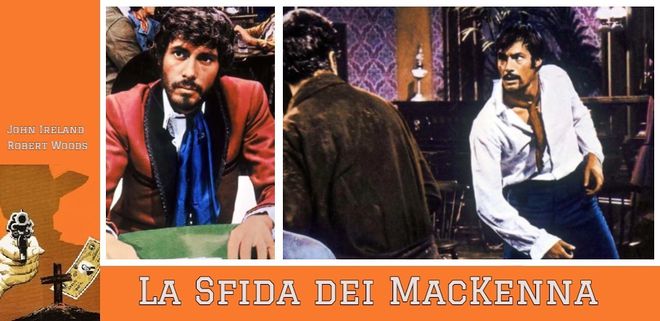Challenge of the McKennas Film Review

A young man is dragged up a rocky slope by three viciously laughing Mexicans to a tree. A young woman, the lover of the man who's about to be hanged, tries to prevent the execution but is pushed aside and finally passes out. Still lying unconsciously on the spot where her fiancee was murdered, she is picked up by a rider passing by, who gives the young man a decent burial and brings her to a nearby ranch: the ranch of Don Diego, who was present at the hanging, and happens to be the girl's father. The passer-by, who calls himself Jonas, is offered a job, on the condition that he buries the corpse anywhere else, that is: outside the confines of Don Diego's properties. Jonas looks around, and asks: "Is all this your land?" " As far as you can see," Don Diego responds, "and for the rest I don't care."
The first ten minutes of the movie tell us a lot: the budget is limited, the actors are fine, and dialogue is witty. What looked like a rocky slope at first, seems more like a gravel pit, the usual excuse for the Almeria desert in low-budget spaghetti westerns. The entire film was shot in Tuscany, near Pisa - a typical Tuscan mansion serving as Don Diego's hacienda - and has a bit of a cheap look. But it also has two of the best genre-actors cast in particularly off-beat roles. John Ireland's Jonas is a former priest who has lost his faith but still refuses to carry a gun, and good old Robert Woods is cast against type as Don Diego's sadistic and perverted son Chris, who seems to have a forbidden desire.

With only a handful of locations and a very tight (but intricate) script, Challenge of the McKennas almost respects the dramatic unities of time, place and action of the Greek tragedy, as defined by Aristotle. With story elements like incestuous love, patricide and wounded pride there are similarities to Ferdinando Baldi's The Forgotten Pistolero (which was based on the classic Greek tragedy of Orestes). None of the characters is really one-dimensional, they all seem frustrated in their ambitions. Even Chris is a tragic character in the sense that he can't have what he desires most: the respect of his father and the love of his sister. Don Diego is a tyrant but we're told by the Lady from the saloon - the proverbial tart with a heart - that things were different in the past: when she arrived in town, long ago, Don Diego was still a decent man who took care of her.
For the first time impersonating the villain in a spaghetti western (a Mexican villain no less), Woods' performance often flirts with parody, but it works, thanks to the contrast with the more restrained performances of both Ireland and Camardiel (as Don Diego). Anabella Incontrera is as delicious as ever as the quite ambiguous Maggie, whose whorehouse/saloon is the last safe resort for the hopeless in town (but they're kicked out at closing time!). The only thing that doesn't really click, is her romance with the ageing Ireland, who is old enough to be her father. Ireland is believable as a disillusioned priest turned drifter, but not very convincing as a ladies man. For the barroom brawl he was 'doubled' by a man who was at least twenty years younger.

Challenge of the MacKennas is way above average, but it's also a bit of an odd genre entry, more drama than action (*1). The characters are well-drawn, but the division of tasks is unusual. Jonas is the stranger in town, whose arrival sets things in motion, but he's almost a bystander, a person who is present at the events but doesn't really participate in them. Essentially this is a movie about the disintegration of a family. There has been quite some discussion on who actually directed this movie. Since one of the screenwriters was Eduardo Mulargia, the director of several spaghetti westerns, some presumed he did most of the direction. According to Woods (talking to Giusti) Klimovsky was responsible for technical aspects such as framing, but didn't talk much with the actors; Ireland and Woods actually 'directed' most dramatic scenes (*2). A remarkable aspect is the amount of Christian symbolism involving fish. Remember that the fish is a symbol of the Christ. furthermore Ireland's character is an ex-priest and calls himself Jonas, Greek for the Hebrew Jonah, who lived inside the whale for some time. In a crucial flashback, we learn that Jonas has killed the Christ in him when he shot his adulterous wife and her lover.
Dir: Leon Klimovsky – Cast: John Ireland, Robert Woods, Roberto Camardiel, Annabella Incontrera, Daniela Giordana, Vidal Molina, Giovanni Cianfriglia, Nando Poggi, Sergio Mendizábal – Music: Francesco de Masi
Notes:
- (1) The Italian working title was Un Dollaro e una Tomba, but this was changed when the Hollywood western McKenna’s Gold turned out to be a big hit in Italy. But who are supposed to be the MacKennas? It has been suggested that John Ireland was a Mckenna, that is: the sole Mckenna who had mysteriously survived a range war between his family and the family of Don Diego, but the actual Italian title says The Challenge of the Mckennas (plural), not McKenna (singular). The name 'Chris' could imply that the family of Don Diego was of mixed descent, but they"re never linked to the name Mackenna, at least not in the English language version
- (2) Marco Giusti, Dizionario del western all'italiana




